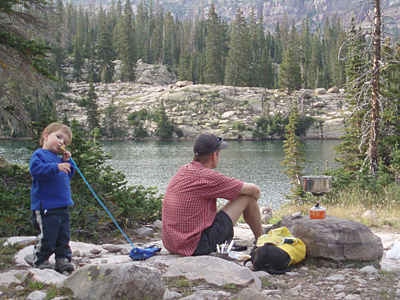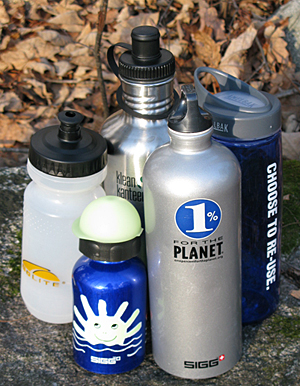Prevent Dehydration with Proper Hydration

Make sure everyone in your group drinks early and often.
(photo: A. MacLeay)
Dehydration is a serious concern during outdoor activities. It can happen in summer or winter, on a day hike or several days into a 50-miler, even on a canoe or kayak trip. Vigorous activity, excessive sun exposure, forgotten water breaks, higher altitudes (where humidity levels are lower), and medical conditions are a few factors that can affect your hydration level.
Some of the consequences of dehydration are loss of energy and motivation, irritability, headaches, difficulty sleeping, fainting, and, at high altitude, an increased likelihood of altitude sickness, hypothermia, and frostbite. In extreme cases, dehydration can lead to delirium and even death.
Essentially, if you’re losing more fluids than you’re taking in, dehydration is the result. So it’s important to stay sufficiently hydrated while hiking, backpacking, or climbing.
However, water sources in the backcountry, or even at the trailhead, are not normally assured of being safe for consumption. So learning how to treat backcountry water is essential to ensure safe water supplies and proper hydration (see “Part 4: Methods for Making Water Safe,” coming 12/8/2008).
Dehydration Signs and Symptoms
The rule for judging whether someone is becoming dehydrated is the phrase “Clear and Copious.” This means that one’s urine should not have a strong color and that urination should be fairly frequent. If your urine is not clear like gin to pale yellow, you are dehydrated. Dark yellow indicates serious dehydration.
It takes time for the body to absorb fluids, so you must drink early and often. Make sure everyone, youths and adults, is drinking plenty of water. “Saving” your water for later can result in dehydration instead. Trip leaders and other adults should make sure to not neglect their own hydration needs.
Thirst is not necessarily an indicator of dehydration. The body’s thirst signal starts when you are 2 to 5 percent dehydrated, according to Dr. Eric Weiss. That person who is acting crankier than usual may be dehydrated, so take frequent water breaks (every 20 to 30 minutes). Consider using a hydration reservoir; its easy access means you never need to stop for a drink.
Rate of Moisture Loss

There’s no shortage of water bottles (stainless steel, aluminum, non-BPA plastic), hydration reservoirs, and water filters, purifiers, and treatments available. (photo: A. MacLeay)
Some of us, especially those brought up in desert regions, were taught to “conserve our water,” saving the small amounts available as long as possible; we were told we could quell the thirsty feeling by holding a small round pebble in our mouths and sucking on it. The problem with these misconceptions, is that we lose moisture in our breath and by sweating. For example, during eight hours of sleep about one liter of moisture is lost through breathing and another liter is lost through perspiration. The rate is even faster when exercising vigorously.
A good way to find your personal rate of moisture loss during exercise is the same as that used in professional and international competitions—weigh yourself before, during, and after an exercise session. It is, of course, impractical to weigh yourself during a hike, but you can weigh yourself before and after a training hike. Each pound you lose during exercise is a pint (half liter) of water lost. Be sure to account for any water and fluids you take in during the hike. In ultra-marathons and other endurance competitions, competitors are usually pulled from the event if they lose more than 5 percent of their body weight.
How Much Water?
The basic rule for avoiding dehydration is to drink plenty of fluids, but this doesn’t means just any fluid. Diuretics (such as caffeine, alcohol, and a number of medicines, including Diamox commonly taken for altitude sickness) promote dehydration. The body does not absorb highly sugared or carbonated beverages as rapidly, which means that soft drinks are less efficient at quenching thirst than plain water. And some adults down a few malt beverages at the end of a hot day believing that they are rehydrating, but research shows quite the opposite.
The best way to keep hydrated or to rehydrate is with plain water or water with one of the specially developed rehydration mixes added.
Someone exercising hard may lose more than a liter (quart) of water an hour. So a good guideline for vigorous activities at altitude is a minimum of 4 liters a day, up to as much as 8 liters. For example, this might mean consuming a liter at breakfast (including hot drinks and fluids in cereal and fruit), one liter between breakfast and lunch (take frequent water breaks), a half-liter with lunch, a liter between lunch and supper (more water breaks), and a final liter at supper (including in the form of soups, hot drinks, and the main course). Many people find that staying well-hydrated is key to a good night’s sleep. Remember that caffeine is a diuretic, so coffee, tea, and chocolate are not as effective as non-caffeinated drinks.
Continued in “Part 2: Keeping Your Water Supply Safe” »
Read Water Treatment and Storage Reviews »

 by Bill Straka
by Bill Straka









